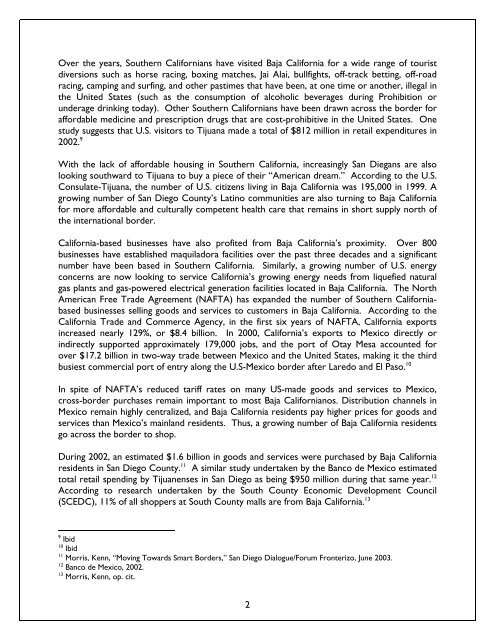Blurred Borders - International Community Foundation
Blurred Borders - International Community Foundation
Blurred Borders - International Community Foundation
Create successful ePaper yourself
Turn your PDF publications into a flip-book with our unique Google optimized e-Paper software.
Over the years, Southern Californians have visited Baja California for a wide range of tourist<br />
diversions such as horse racing, boxing matches, Jai Alai, bullfights, off-track betting, off-road<br />
racing, camping and surfing, and other pastimes that have been, at one time or another, illegal in<br />
the United States (such as the consumption of alcoholic beverages during Prohibition or<br />
underage drinking today). Other Southern Californians have been drawn across the border for<br />
affordable medicine and prescription drugs that are cost-prohibitive in the United States. One<br />
study suggests that U.S. visitors to Tijuana made a total of $812 million in retail expenditures in<br />
2002. 9<br />
With the lack of affordable housing in Southern California, increasingly San Diegans are also<br />
looking southward to Tijuana to buy a piece of their “American dream.” According to the U.S.<br />
Consulate-Tijuana, the number of U.S. citizens living in Baja California was 195,000 in 1999. A<br />
growing number of San Diego County’s Latino communities are also turning to Baja California<br />
for more affordable and culturally competent health care that remains in short supply north of<br />
the international border.<br />
California-based businesses have also profited from Baja California’s proximity. Over 800<br />
businesses have established maquiladora facilities over the past three decades and a significant<br />
number have been based in Southern California. Similarly, a growing number of U.S. energy<br />
concerns are now looking to service California’s growing energy needs from liquefied natural<br />
gas plants and gas-powered electrical generation facilities located in Baja California. The North<br />
American Free Trade Agreement (NAFTA) has expanded the number of Southern Californiabased<br />
businesses selling goods and services to customers in Baja California. According to the<br />
California Trade and Commerce Agency, in the first six years of NAFTA, California exports<br />
increased nearly 129%, or $8.4 billion. In 2000, California’s exports to Mexico directly or<br />
indirectly supported approximately 179,000 jobs, and the port of Otay Mesa accounted for<br />
over $17.2 billion in two-way trade between Mexico and the United States, making it the third<br />
busiest commercial port of entry along the U.S-Mexico border after Laredo and El Paso. 10<br />
In spite of NAFTA’s reduced tariff rates on many US-made goods and services to Mexico,<br />
cross-border purchases remain important to most Baja Californianos. Distribution channels in<br />
Mexico remain highly centralized, and Baja California residents pay higher prices for goods and<br />
services than Mexico’s mainland residents. Thus, a growing number of Baja California residents<br />
go across the border to shop.<br />
During 2002, an estimated $1.6 billion in goods and services were purchased by Baja California<br />
residents in San Diego County. 11 A similar study undertaken by the Banco de Mexico estimated<br />
total retail spending by Tijuanenses in San Diego as being $950 million during that same year. 12<br />
According to research undertaken by the South County Economic Development Council<br />
(SCEDC), 11% of all shoppers at South County malls are from Baja California. 13<br />
9<br />
Ibid<br />
10<br />
Ibid<br />
11<br />
Morris, Kenn, “Moving Towards Smart <strong>Borders</strong>,” San Diego Dialogue/Forum Fronterizo, June 2003.<br />
12<br />
Banco de Mexico, 2002.<br />
13<br />
Morris, Kenn, op. cit.<br />
2















